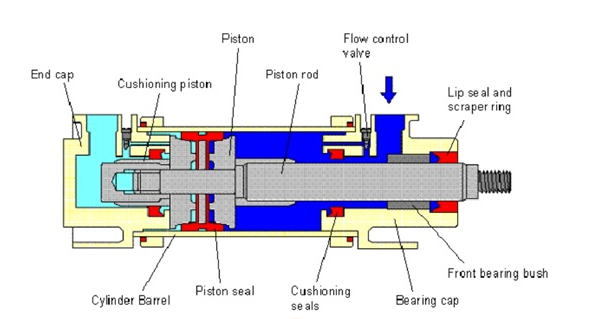What is a pneumatic cylinder? What are the types of pneumatic cylinder?

What are pneumatic cylinder and what is the function of pneumatic cylinder?
A pneumatic cylinder is also called pneumatic actuators is a device that is used in industrial automation applications to provide motion and force. A pneumatic cylinder uses compressed air to create force. This device is widely used in automated systems, machines, and processes. Movement of the products is done directly or indirectly by the pneumatic cylinder and the load will be moved by pushing, pulling, etc. These devices are not costly and can be installed easily. This device can create a huge amount of force over a board range of velocities without overheating or internal damage. Its operation is not affected by its environment conditions like it can be used in dusty and high humidity locations.
How does a pneumatic cylinder work?
A pneumatic cylinder uses compressed air for its operation it is a linear actuator. The compressed air will be converted into kinetic energy or it can also be described as the conversion of potential energy into kinetic energy. This kinetic energy is used in the loads to move it. So when the compressed air is converted into kinetic energy the air will expand so that it can reach the atmospheric pressure. The piston in the cylinder is forced by the expanded air in the desired direction. The piston is mostly a disc or cylinder, and the piston rod will transfer the generated force to the object that is to be moved.
What are the types of a pneumatic cylinder and how does it work?
Single-acting cylinders
This device uses the pressure imparted by the compressed air to create a driving force in one direction and it would return back to its position with the help of a spring. The extension of this cylinder is limited because of the space that the compressed spring uses. This device has another disadvantage that it would lose some force when it tries to push the spring and because of this, the single-acting cylinders are not used in applications where high force is required.
What are the advantages of a single-acting cylinder?
Defined position in the event of power failure
Reduced air consumption
Easy actuation
What are the disadvantages of a single-acting cylinder?
The construction length of the cylinder is long
Force is built up in one direction
No constant force
Force will be reduced by the spring force
Double-acting cylinders
Double-acting cylinders uses the force of the compressed air to move the rod, this type has a piston rod and this piston rod does the transfer of compressed air to the load. There is also a cushioning piston at the rod end and it won’t allow any hard shocks at the end of the stroke, this is done by stopping the piston slowly and gently. There is an airtight seal between the piston and the rod piston and it is achieved by a static seal. Metal to metal contact of the piston and the cylinder is prevented with the help of a piston guide ring. There are air-ports in both ends of the cylinder and through these air-ports the compressed air will flow in and out of the cylinder. The piston will move away from the cylinder during the extension stroke and comes back during the retraction stroke and this is achieved by the compressed air and this way it moves the load.
What are the advantages of double-acting cylinders?
Constant force
Force can be built in both side of the direction
Strokes of several meters can be achieved
What are the disadvantages of double-acting cylinders?
It uses compressed air for each movement
In the event of compressed air failure, there is no defined position
How pneumatic cylinders are constructed and what are its parts?
According to the specified applications the pneumatic cylinders are constructed in multiple forms. The most common cylinder construction is tie rod cylinders and it is used for many types of loads. Flanged type and threaded end cylinders are the other type of construction. The material that is used for the construction would range from nickel-plated brass to aluminum and also steel and stainless steel are also used. The material is selected according to the level of loads, humidity, temperature, and stroke.

Piston rod – it is a part in the cylinder which transmits the force and movement of the cylinder to outside
Cylinder barrel – it is the section in which the sensors and other attachments parts can be mounted.
Pistons – this part is connected to the piston rod, and this will help for the proper movement. It also acts as a seal between the front and rear cylinder chamber.
Bearing caps – this part closes the cylinder on one side and it would also act as a bearing and the sealing point for the piston rod.
End caps – this part will close the cylinder on the other side. Mostly the second air connection can be seen in end cap.
What are the applications of pneumatic cylinder?
Pneumatic cylinders are used in factories
Production lines
Processing plants
Airbrushing and spray painting
Pneumatic drill
Pick and place
It can also be used for certain purposes such as moving, holding, or shaping the object
Artical from: https://automationforum.co/what-is-a-pneumatic-cylinder-what-are-the-types-of-pneumatic-cylinder/
Latest News
-
ORBINOX EK (SER.15) Uni-directional high performance knife gate valve
 November
21, 2025
November
21, 2025
-
ORBINOX EX (SER.10) model Knife Gate Valve
 November
21, 2025
November
21, 2025
-
Samson 3260/3 pneumatic - DIN Globe valve
 November
14, 2025
November
14, 2025
